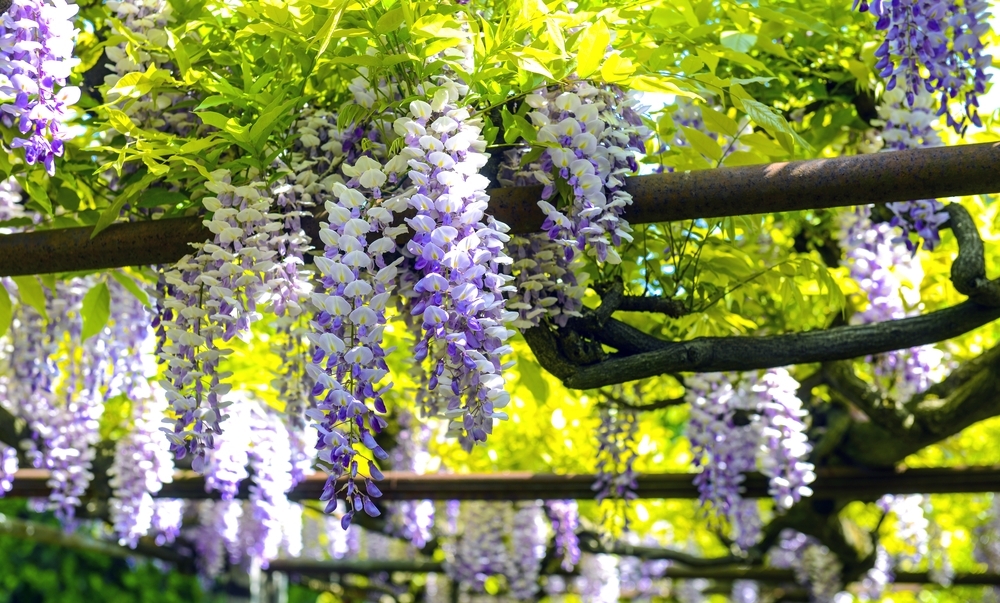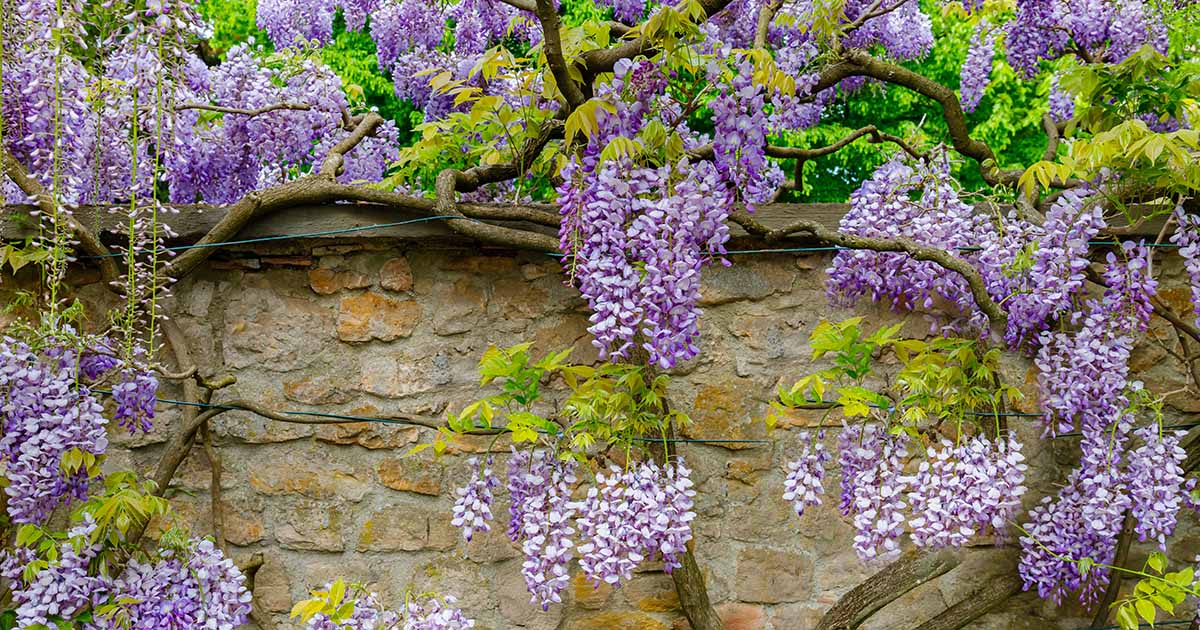Choosing the Perfect Wisteria Variety for Your Garden
Wisteria is a stunning flowering plant that can add beauty and elegance to any garden. With over 10 species and countless cultivars, choosing the right variety can be a daunting task. However, by understanding the characteristics of each type, you can make an informed decision and enjoy the benefits of these magnificent plants.
Chinese wisteria (Wisteria sinensis) is one of the most popular varieties, known for its vibrant purple flowers and robust growth habit. This variety is ideal for gardeners in USDA zones 5-9 and can thrive in a range of soil conditions. Japanese wisteria (Wisteria floribunda), on the other hand, is renowned for its delicate pink flowers and more compact growth habit, making it perfect for smaller gardens or containers.
American wisteria (Wisteria frutescens) is a lesser-known variety, but it’s gaining popularity due to its unique characteristics. This variety produces white or purple flowers and has a more restrained growth habit, making it suitable for gardeners in USDA zones 4-8. When selecting a wisteria variety, consider factors such as flowering color, growth habit, and hardiness zone to ensure you choose the perfect plant for your garden.
Before learning how to plant a wisteria, it’s essential to understand the specific needs of your chosen variety. By selecting the right variety and providing the optimal growing conditions, you’ll be rewarded with a stunning display of flowers and a thriving plant that will bring joy to your garden for years to come.
Preparing the Ideal Soil and Location for Wisteria
Wisteria is a versatile plant that can thrive in a variety of soil conditions, but it does have some specific requirements to ensure optimal growth and flowering. When learning how to plant a wisteria, it’s essential to understand the importance of soil preparation and selecting the right location.
Wisteria prefers well-draining soil with a pH between 6.0 and 7.0. It can tolerate a range of soil types, from clay to sand, but it’s crucial to ensure the soil is rich in organic matter. Adding compost or well-rotted manure can help improve soil fertility and drainage. Additionally, wisteria requires adequate nutrients, particularly nitrogen, phosphorus, and potassium, to promote healthy growth and flowering.
In terms of location, wisteria needs full sun to partial shade to produce an abundance of flowers. It’s also essential to provide good air circulation to prevent disease and promote healthy growth. Avoid planting wisteria in areas with standing water or where water tends to collect, as this can lead to root rot and other problems.
When selecting a location for your wisteria, consider the mature size of the plant and its growth habit. Wisteria can grow quite large, so ensure you provide enough space for the plant to spread out. Also, consider the location of nearby plants and structures, as wisteria can become quite heavy and may require support.
By preparing the ideal soil and location for your wisteria, you’ll be well on your way to growing a healthy and thriving plant that will provide you with years of beauty and enjoyment.
How to Plant a Wisteria: A Step-by-Step Guide
Planting a wisteria can be a rewarding experience, but it requires careful planning and execution. By following these steps, you’ll be able to give your wisteria the best possible start in life and enjoy its beauty for years to come.
Before planting, make sure you’ve selected a location with the right soil and sunlight conditions for your wisteria. Once you’ve chosen the perfect spot, it’s time to start preparing the soil. Dig a hole that’s twice as wide and just as deep as the root ball of your wisteria. If your soil is heavy clay or sandy, mix in some organic matter like compost or well-rotted manure to improve its structure.
Next, gently remove the wisteria from its container and place it in the hole. Make sure the root flare (where the stem flares out at the base of the plant) is level with the soil surface. Fill in the hole with soil, tamping it down gently as you go to remove any air pockets. Water the soil well to settle it around the roots.
Proper planting depth and spacing are crucial for the health and success of your wisteria. Plant the wisteria at the same depth it was in the container, and space it at least 10-15 feet away from any other plants or structures. This will give the wisteria room to grow and receive adequate air circulation.
After planting, water your wisteria regularly to keep the soil consistently moist during the first growing season. This will help the plant establish a strong root system and promote healthy growth. With proper care and attention, your wisteria will thrive and provide you with years of beauty and enjoyment.
Supporting Your Wisteria: The Importance of Pruning and Training
Wisteria is a vigorous grower that requires regular pruning and training to control its growth and promote flowering. Pruning is essential to maintain the plant’s shape, encourage new growth, and increase flower production. Training, on the other hand, helps to direct the plant’s growth and keep it tidy.
There are several pruning techniques that can be used to support wisteria growth. Tip-pruning involves cutting back the tips of the stems to encourage branching and promote flower production. Thinning involves removing select stems to allow more sunlight to reach the remaining stems and promote healthy growth. Pruning should be done in late winter or early spring, before new growth begins.
Training wisteria to a trellis or arbor is also important to provide support for the plant’s vigorous growth. A sturdy trellis or arbor can help to keep the plant upright and promote vertical growth. Train the stems to the trellis or arbor by gently twining them around the support. This will help to keep the plant tidy and promote healthy growth.
Regular pruning and training are essential to keep wisteria healthy and promote flowering. By following these tips, you can enjoy a beautiful and thriving wisteria plant that will provide you with years of enjoyment. Remember to prune and train your wisteria regularly to keep it healthy and promote optimal growth.
When learning how to plant a wisteria, it’s essential to understand the importance of pruning and training. By providing the right support and care, you can enjoy a stunning display of flowers and a healthy, thriving plant.
Watering and Fertilizing Your Wisteria: Tips for Optimal Growth
Wisteria requires consistent moisture, especially during the first growing season after planting. It’s essential to water your wisteria regularly, but make sure not to overwater, as this can lead to root rot and other problems. Aim to provide about 1 inch of water per week, either through rainfall or irrigation.
Fertilizing your wisteria is also crucial for optimal growth and flowering. Use a balanced fertilizer (10-10-10) in the early growing season, and a high-phosphorus fertilizer (10-20-10) in the late growing season to promote blooming. Avoid overfertilizing, as this can damage the plant and lead to weak growth.
When learning how to plant a wisteria, it’s essential to understand the importance of watering and fertilizing. By providing the right amount of moisture and nutrients, you can promote healthy growth and encourage blooming. Remember to water and fertilize your wisteria regularly to keep it thriving.
Some additional tips to keep in mind when watering and fertilizing your wisteria include:
- Water your wisteria in the morning to allow the plant to absorb the water throughout the day.
- Avoid getting water on the leaves or flowers to prevent fungal diseases.
- Use a drip irrigation system or soaker hose to deliver water directly to the roots.
- Fertilize your wisteria in the early growing season, when new growth begins.
By following these tips, you can provide your wisteria with the right amount of water and nutrients to promote optimal growth and flowering.
Common Pests and Diseases Affecting Wisteria: How to Identify and Manage
Wisteria is generally a hardy and disease-resistant plant, but it can be susceptible to certain pests and diseases. Regular monitoring and maintenance can help prevent infestations and infections, but it’s essential to know how to identify and manage common issues.
Aphids are small, soft-bodied insects that feed on plant sap, causing curled or distorted leaves. Whiteflies are tiny, winged insects that feed on plant sap, causing yellowing or stunted growth. Root rot is a fungal disease that causes roots to rot, leading to plant decline or death.
To manage aphids and whiteflies, use neem oil or insecticidal soap to control infestations. For root rot, improve soil drainage and avoid overwatering. Fungal diseases can be treated with fungicides, but it’s essential to follow the product instructions carefully.
Other common pests and diseases affecting wisteria include spider mites, scale, and powdery mildew. Regularly inspect your plant for signs of infestation or infection, and take action promptly to prevent the issue from spreading.
When learning how to plant a wisteria, it’s essential to understand the potential risks and take steps to prevent them. By monitoring your plant regularly and taking action promptly, you can prevent infestations and infections and enjoy a healthy, thriving wisteria.
Some additional tips to keep in mind when managing pests and diseases on your wisteria include:
- Use physical barriers, such as fine-mesh screens, to prevent whiteflies and aphids from reaching your plant.
- Practice good garden hygiene, such as removing weeds and debris, to reduce the risk of disease transmission.
- Use organic or chemical controls as a last resort, and always follow the product instructions carefully.
By following these tips, you can help prevent pests and diseases from affecting your wisteria and enjoy a healthy, thriving plant.
Wisteria Care Through the Seasons: A Year-Round Guide
Wisteria is a beautiful and versatile plant that requires regular maintenance to ensure optimal growth and flowering. By following a seasonal guide to wisteria care, you can keep your plant healthy and thriving throughout the year.
In the spring, wisteria requires regular watering and fertilization to promote new growth and flowering. Prune your wisteria in late winter or early spring to control its vigorous growth and promote blooming. Also, inspect your plant for signs of pests or diseases and take action promptly to prevent infestations or infections.
During the summer, wisteria requires consistent moisture and regular fertilization to promote healthy growth and flowering. Deadhead your wisteria regularly to encourage more blooms and prevent seed production. Also, provide support for your wisteria by training it to a trellis or arbor.
In the fall, wisteria requires less water and fertilizer as it prepares for dormancy. Prune your wisteria in late fall to control its growth and promote blooming the following spring. Also, inspect your plant for signs of pests or diseases and take action promptly to prevent infestations or infections.
During the winter, wisteria requires minimal maintenance as it is dormant. However, it’s essential to protect your plant from extreme cold and wind by providing a layer of mulch or burlap. Also, inspect your plant for signs of pests or diseases and take action promptly to prevent infestations or infections.
By following this seasonal guide to wisteria care, you can keep your plant healthy and thriving throughout the year. Remember to prune, water, and fertilize your wisteria regularly to promote optimal growth and flowering.
Some additional tips to keep in mind when caring for your wisteria include:
- Monitor your plant regularly for signs of pests or diseases and take action promptly to prevent infestations or infections.
- Provide support for your wisteria by training it to a trellis or arbor.
- Deadhead your wisteria regularly to encourage more blooms and prevent seed production.
By following these tips, you can enjoy a beautiful and thriving wisteria plant that will provide you with years of enjoyment.
Enjoying the Fruits of Your Labor: Wisteria Bloom Time and Beyond
Wisteria is a beautiful and fragrant plant that produces stunning flowers in shades of purple, pink, and white. The bloom time of wisteria typically lasts for several weeks in the spring, and it’s a time of great anticipation and excitement for gardeners.
During bloom time, wisteria produces long, fragrant flowers that cascade down from the plant’s stems. The flowers are highly fragrant and attract a variety of pollinators, including bees and butterflies. To enjoy the blooms for as long as possible, it’s essential to deadhead the flowers regularly, which involves removing the spent blooms to encourage the plant to produce more flowers.
Beyond bloom time, wisteria can still be enjoyed in a variety of ways. The plant’s foliage is attractive and can be used as a focal point in the garden. Wisteria can also be incorporated into floral arrangements, adding a touch of elegance and sophistication to any room.
Some additional ways to enjoy wisteria beyond bloom time include:
- Using the plant as a trellis or arbor, providing shade and structure to the garden.
- Incorporating wisteria into a sensory garden, where the plant’s fragrance and texture can be enjoyed.
- Using wisteria as a cut flower, adding a touch of elegance to floral arrangements.
By enjoying wisteria beyond bloom time, gardeners can appreciate the plant’s beauty and fragrance throughout the growing season. Whether used as a focal point in the garden or incorporated into floral arrangements, wisteria is a versatile and beautiful plant that can bring joy and beauty to any garden.
When learning how to plant a wisteria, it’s essential to understand the importance of enjoying the plant’s beauty beyond bloom time. By incorporating wisteria into your garden design and enjoying its beauty throughout the growing season, you can appreciate the plant’s full potential and enjoy its beauty for years to come.









